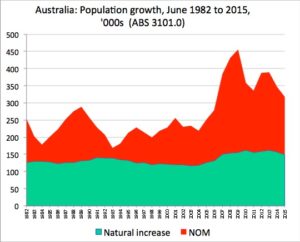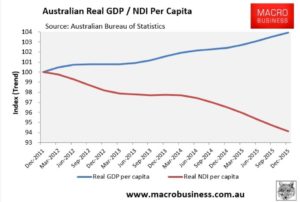By Bob Birrell, republished from John Menadue – Pearls and Irritations 13 January 2017
There are many indicators of GP over-supply in Australia. … One consequence has been an escalation in the cost of GP rebates to the taxpayer. … Better distribution of GP services could be achieved by restricting new provider numbers to under-supplied districts.
There are many indicators of GP oversupply in Australia. Over the decade to 2014-15 the number of GPs accessing primary care rebates on Medicare increased by 47.4 per cent. Over the same period Australia’s population increased by 18.7 per cent. The result was a sharp increase in the per capita number of GP services billed, from 4.7 in 2004-05 to 5.7 in 2014-15. The increase in per capita service provision was even stronger in Australia’s metropolitan areas, where GPs have been concentrating and the oversupply is most acute. Australia is close to the top in the ratio of working doctors to population within OECD nations.
GPs practicing in oversupplied locations have to chase patients. This has encouraged high throughput medicine, in which doctors prescribe multiple tests and recommend repeat patient visits. Patients, for the most part, accept this because they do not pay the costs. Currently 85 per cent of all GP services are bulk-billed. High throughput medicine depends on bulk-billing. Any GP that charges a co-payment in an oversupplied area will quickly lose patients.
One consequence has been an escalation of the cost of GP rebates to the taxpayer, from $3.3 billion in 2004-05 to $6.8 billion in 2014-15 and $7.2 billion in 2015-16. The costs for Pharmaceutical Benefits and screening tests have jumped as well.
These costs will continue to rise because of the increase in the number of domestic medical school graduates, from 1,320 in 2005 to 3,055 in 2015. The number of these graduates taking up GP training places has grown from 450 in 2004 to 1,529 in 2015. Once these Australian Trained Doctors (ATDs) obtain their GP Fellowship they can practice where they wish. Despite a raft of incentives to serve in undersupplied areas the great majority are choosing to practice in metropolitan areas.
Large numbers of Overseas Trained Doctors (OTDs) are adding to the metropolitan supply. This arises as follows. Since the early 2000s successive Australian governments have dealt with shortages of GPs in regional areas by facilitating the recruitment of OTDs on 457 visas. These 457 visas are only issued for specific jobs in GP practices and hospitals in locations defined as Districts of Workforce Shortage (DWS). Thousands of such visas are issued each year, including 2,320 in 2015-16. An indication of the scale of this recruitment is that it is more than the 1,529 GP training places allocated in 2015.
After serving a prescribed period in a DWS (from 5-10 years depending on remoteness of location) OTDs can bill on Medicare where they please (just like ATDs). Most move to metropolitan areas or to major regional centres. This movement is the main contributor to the rapid growth in the number of GPs billing on Medicare in metropolitan areas.
Given current medical migration policy this metropolitan flow will continue, because the government is allowing employers in DWS to sponsor replacements for the OTDs who leave. They are doing so in large numbers, as is indicated by the 2,320 457 visas issued in 2015-16. In time, many of these OTDs will move to metropolitan areas, where they will compete for patients with the impending surge of ATDs described above.
The Department of Health takes a stand
In 2016 the Department of Health (DoH) admitted the seriousness of the oversupply situation and announced some radical proposals affecting the recruitment and location of GPs. This arose in the context of the 2016-17 review of the Skilled Occupation List (SOL). The DoH recommended that GPs (and most specialists) be taken off the SOL. The significance of SOL listing is that migrants seeking permanent entry visas under the points-tested visa subclasses must have an occupation that is included on the SOL. The SOL does not affect eligibility for a 457 visa since almost all professional, managerial and trade occupations are open for sponsorship.
However DoH accompanied its SOL recommendations with a statement that it intended to reduce medical migration and to ensure that newly minted ATDs fill the resulting vacancies in underserviced areas. DoH can stop OTD recruitment on 457 visas by abolishing the DWS arrangements. At present OTDs can only be sponsored for a 457 visa if their employer specifies a GP position in a DWS.
The Coalition Government rejected this advice. It did so for two reasons. The first was that it does not want to remove major occupations from those eligible for its points-tested visa subclasses. To do so would gut the migration program, an outcome the government will not countenance. To this end the government has changed the criteria determining listing on the SOL. It has stipulated that the current state of the labour market in particular occupations is no longer relevant. All that now matters is the ‘medium to long term’ skill needs for the occupations under review.
To illustrate, the Department of Employment and Training’s recent surveys show clear evidence of excess numbers of applicants to job vacancies for accountants, ICT professionals and engineers. Yet each of these occupations remain on the SOL. All the occupations listed, as well as doctors, remain on the SOL because according to the government’s judgement of the medium term outlook, there will be a need for additional professionals in each field.
Our investigation indicates that these judgements are being made on the basis of outdated employment projections prepared during the resources boom era. The DoH recommendations for doctors were particularly interesting in this context because they challenged these projections (even if to no avail).
The second reason for the government’s reluctance to accept the DoH advice was fear about the likely reaction of organised medicine. If medical immigration ceased and ATDs entering the workforce were required to fill the resulting vacancies, this would abrogate the longstanding right of ATDs to practice where they wish. The policy would be labelled as conscription.
This is not the case. GPs are public servants, as the 85 per cent bulk-billing rate indicates. Public servants, such as teachers, can choose to work wherever there are vacancies. Likewise for GPs. Under the reforms implied by the DoH, GPs who finish their training would be free to work in any of the many locations — mainly in regional Australia, but also in after-hours service in metropolitan areas — where their services are needed. This could easily be accomplished by restricting new provider numbers to undersupplied districts.
This article is drawn from Mike Moynihan and Bob Birrell, GP Oversupply – Ignoring the Evidence, The Australian Population Research Institute, December 2016.
Bob Birrell is head of The Australian Population Research Institute.


